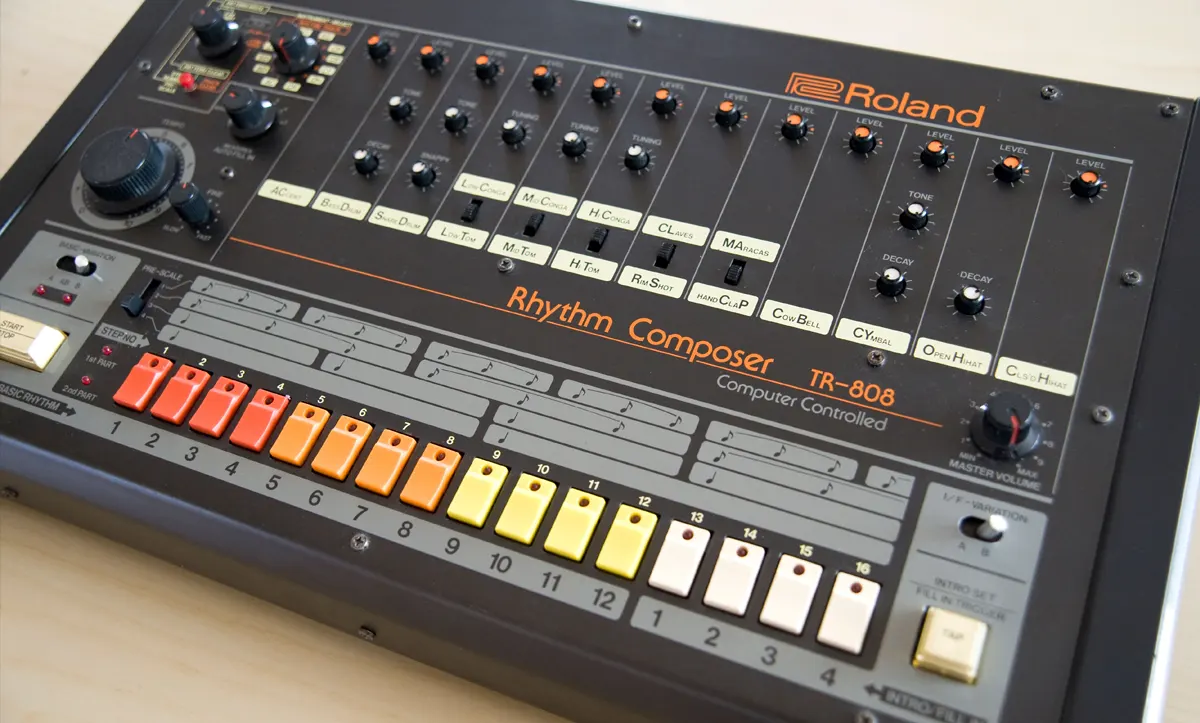
We may earn a commission from the affiliate links on this site. Learn more›
Whether you’re an experienced producer or just a beginner, a drum machine is one of the greatest tools to have in your writer’s toolbox. We tested out eight popular products and picked out the best machine for beginners. Read more to see which ones we liked.
Now, these types of instruments should not be confused with drum pads, which are generally hit with sticks. Some drum pads contain drum machines, but not all drum pads are drum machines. Get it?
1) Erica Synths Perkons HD-01 Drum Machine 9/10
4-voice Drum Machine with 4-track Sequencer, 4 Trigger Inputs, Multimode Analog Filter, FX Send/Returns, BBD Delay, and Modulation LFO
The Perkons HD-01 is a four voice drum machine and rhythm synthesizer that produces both digital and analog sounds. It has a multimode filter, velocity sensitive trigger inputs for drum pads, and eight controls per voice.
The Perkons also has a flexible modulation LFO and 64 kit and 64 pattern memory. Additionally, it has MIDI I/O for connecting to other devices.
The Perkons HD-01 isn’t out yet, but will be available soon. Perkons instruments are perfect for anyone who wants to create their own beats and rhythms.
They’re also great for those who want to add another layer of sound to their music. Whether you’re a beginner or a seasoned pro, the Perkons HD-01 is a great choice for anyone looking for a versatile drum machine and rhythm synthesizer.
2) Roland Aira Compact T-8 Beat Machine 8/10
Portable Drum Machine and Bass Synthesizer with 32-step Sequencer, FX, Audio, MIDI, USB-C and Sync I/O
Roland has been a trusted name in electronic instruments for decades, and their new Aira Compact T-8 Beat Machine is a welcome addition to their lineup.
This portable drum machine is perfect for taking on the go, thanks to its lightweight and compact design. It also boasts a 32-step sequencer, making it easy to create complex rhythms.
In addition, the Roland Aira Compact T-8 Beat Machine contains the classic Roland TR-606, TR-808, TR-909, and TB-303 sounds, giving you a wealth of options to choose from.
And with its powerful FX engine and onboard MIDI, the Aira Compact T-8 is sure to meet all of your needs. Best of all, it comes with a rechargeable lithium-ion battery that provides 4.5 hours of use, making it the perfect companion for your next adventure.
3) Akai Professional MPD218 8/10
Akai is one of the most notable companies when it comes to MIDI controllers. They have an excellent line of products that feature both great design and lots of features.
The Akai MPD218 is a fantastic drum machine for beginners. Let’s take a look at why.
Quick Overview
The Akai MPD218 is your standard MIDI sampling pad. It connects to your computer via USB and works with any Digital Audio Workstation. Since it is not analog, you will need to have a computer with a DAW for it to function.

There are no onboard sounds as it is just a MIDI controller. Included with is over $400 of software including Akai Pro MPC Essentials, Big Bang Drums and Big Bang Cinematic Percussion from Sonivox, Ableton Live Lite, and Software Preset Editor.
Quality of the pads
The pads on the Akai are incredible. They feature a velocity-sensitive mode that sounds very realistic. Of course, if you want your snare drum to sound like a machine gun, you can turn this feature off.

With the MPD218, you’ll be jamming in no time. There are tons of drum patches, arpeggiators, and lots of unique synth sounds. You can even play chords if need be. The pad layout mapping is very easy to use and understand.
Functionality
Note Repeat is one of the included functions of the MPD218. What is it? It’s a built-in function that repeats a note you play with a selected subdivision. For example, you could have note repeat set to 1/8 notes, and your pad would repeat that note as if it was an eighth note.
This is perfect for creating arpeggiations, cool synth and bass lines, and other unique parts. You can control the subdivisions with a knob, so it’s easy to change on the fly.
In addition to note repeat, there is built-in swing functionality for all your odd-timed parts and ideas. If you’re creating a piece of music that is in a swung or jazz style, this is a perfect application for these genres.
You can also control the “amount” of swing in your parts. The MPD218 does not have a backlit screen, unfortunately. What do we think? It’s a solid drum machine for beginners!
4) Alesis SR16 9/10
Drum Machine, with 12 Performance Pads, 24-bit Sound Engine, 233 Drum Sounds, 50 Preset Patterns, A/B/Fill Variations, and MIDI In/Out/Thru
The Alesis SR16 has been utilized by artists, musicians, and producers since the 90s. Live musicians, lyricists, and music producers have also used it in recording studios or on stage. This instrument comes with over 200 amazing drums sounds.
The finger pads are velocity-sensitive, so it will respond to you playing soft or hard. Velocity

It also features 50 drum kits that were meticulously recorded and sampled from real drum sets, recorded by actual drummers in a recording studio.
The SR16 also features brilliant MIDI implementation, foot switch, lots of editing features, and adjustable programming.

Only the most veteran drummers and music producers will be able to separate the sound of the SR16 with a real drum set.
This drum machine is commended for its quality of sound and is the perfect device for solo artists who don’t have access to a real drummer or who need an inexpensive writing tool.
It can be utilized in a project or home studio and is very lightweight for easy travel.
5) Korg Volca Beats 9/10
Analog Drum Machine with 16-step Sequencer, 10 Drum Parts, MIDI Input, Sync I/O, and Stutter Effect
The Korg Volca Beats is perfect for any traveling musician. Lightweight and powerful, this drum machine is incredible all-around, perfect for any beginner or professional.
Korg’s legendary synths can be heard all throughout this instrument. You also have the option to connect an external MIDI controller for more sonic possibilities.
It includes a 16-step sequencer with eight memory patches. If you have other MIDI devices, you have the option of syncing the clock to your other devices with the word clock. If you have no idea what this means, don’t worry about it. It basically allows you to sync the sequence with your other devices to the same tempo perfectly.
One amazing feature of the Korg Volca is the built-in speaker, allowing it to go anywhere without headphones. You can run the instrument off of batteries, as well.
6) Native Instruments Maschine Mikro MK3 9/10
Groove Production Control Surface and 24-bit/96kHz USB 2.0 Audio Interface with Groove Production Software, 8GB of Samples, and Komplete Select Software Bundle
The Native Instruments Maschine mk3 is one of my favorites on this list. While not a traditional drum machine so to say, it has all the functionality plus many more features.
Included is an 8GB MASCHINE library of amazing sounds. In addition to samples, there a ton of MIDI patterns already pre-programmed into the Maschine software that is used inside your DAW.
My only hang-up is the VST software. It tries to be its own digital audio workstation and results in terrible user experience. To use it, you load Maschine as a VST instrument inside your DAW. From here, Maschine loads up another window that is similar to a DAW.
Now, this isn’t terribly uncommon when integrating other DAWs like Reason with, say, Pro Tools, but the workflow of Native Instrument’s Maschine is horrendous.
This is frustrating, as none of the
I just wanted to produce some music! Not read a bunch of PDFs on routing settings through Maschine into Cubase! With that aside, Maschine mk3 is actually very powerful. The hardware interface is surprisingly easy to use.
You can browse patches, sample sounds, cur sounds, shape them, and perform.
This unit does require a computer as there are no onboard sounds. If the 8GB library isn’t enough for you, there are expansions you can pick up from Native Instruments.
7) Arturia Drumbrute Impact 9/10
Analog Drum Machine with 10 Drum Sounds, 64-step Pattern Sequencing, Song Mode, and Distortion Effect
A large number of drum machines are generally emulations of older hardware that is both hard to find and very expensive. We have been very fortunate in the past few years with all the VST instruments that essentially “clone” older hardware synthesizers to an almost identical sound.
Arturia’s Drumbrute is the company’s second hardware drum machine. Is this the best for beginners? Arturia is a household name when it comes to synthesizers, both hardware, and software. I have loved this company for years, mainly utilizing their V Collection on many of my projects. They are definitely no fly-by-night company.
The DrumBrute is an analog drum synthesizer. It feels and sounds exactly like a classic drum machine. While it remains true to its vintage sound, it also has superior audio specifications and it brings down noise floor further than its classic counterparts.
The DrumBrute features 10 true analog sounds, effects, 64-step pattern sequencer, ease of use, and great connectivity.
Sounds
This thing sounds like it came right out of the 80s. There are tons of cool sound patches that sound like something Depeche Mode might have used, had they had this thing. Arturia wanted the user to feel like they were actually using a vintage drum machine from the past, and that’s the exact user experience I got.
There are twelve physical channels on the DrumBrute:
- Kick
- Snare
- Snare 2
- Tom Hi/Low
- Cymbal/Cowbell
- Closed Hat
- Open Hat
- FM Drive
Some of these channels contain extra buttons, allowing you to switch between sounds. For example, on the Cymbals channel, you can flip to a cowbell with the press of a button.
If I have to critique the DrumBrute for anything, it’s gotta be the snare drums and the hats. While the kick drums and claps this thing synthesizes are fantastic, the snares and hats tend to be a little weak.
Another issue is just the fact that there are only 10 analog sounds. If you go for a digital drum machine, you’ll be able to have an endless amount of sounds at your disposal!
Drum Performance
DrumBrute is not just for making beats. You can tweak your grooves and make them develop any way you want. Arturia DrumBrute includes tons of awesome features such as Step Repeat, Pattern Looper, and song mode, along with Randomness & Swing functions per track.
Music producers will love the capacity to play quantized or semi-quantized on ultra-touchy pads. It includes a metronome, in case you might need it, as well as solo / mute buttons that can be activated when the specified channel or channels are selected. This function is known as group mutes.
The Sequencer
This drum machine for beginners has a very intuitive sequencer and has three different options: song, bank, and pattern. Song mode allows you to tie different patterns together. Banks allow you to manage a group of sixteen total patterns.
There are a total of four banks that can be utilized at once. Patterns can be up to 64 steps and each pattern can contain up to 17 sequencer channels.
Overall – Best drum machine for beginners
The Arturia DrumBrute is our Editor’s Pick for best drum machine for beginners. While the price may seem a little steep, this drum machine is going to give you the best value and will be a long-lasting piece of gear in your arsenal.
On-Board Effects Processing
Pattern effects are another feature that’s very unique and hands-on. Underneath Pattern Effects are two white knobs: Swing and Randomness.
You can add these globally to the entire sequence, or add them on a track-to-track basis, using the Current Track button. Finally on the far right is the Step Repeat function. This strip allows you to create unique drum “fills” by just pressing on the strip at any point.
Options are 1/4, 1/8, 1/16, and 1/32.
Above the Pattern Effects is the Output Filter. If you have worked with other synthesizers before, you probably will understand how this works immediately.
The filter has just two knobs: cutoff and resonance. All you have to do is adjust these knobs and you’ll get the feel for it relatively quick. This knob is useful in creating cool EDM sweeps typically heard with electronic music.
8) Roland Rhythm Composer TR-08 8/10
Drum Sound Module with 16-step/16-sub-step Sequencer, USB Output, LED Display, Built-in Speaker, and Compressor, Gain, Tune, and Pan
The Rhythm Composer TR-08 is a faithful recreation of the original TR-808. I originally wrote this section on the Aira TR-8, but the TR-08 is a far-better recreation of the 808. The TR-808 and TR-909 are the predecessors of the Roland Aira TR-8. Everyone and their mother knows of the 808 and 909.
They have been used on countless numbers of records and are still even used to this day. These drum machines were the basis for all kinds of music. Today, these sequencers are hard to find and nothing beats the original.
Roland’s TR-8 is a hybrid instrument, in that, it has both the TR-808 and TR-909 built-in. You can also create hybrid kits out of it, as well.
The drum machine has all of the features and capabilities that the original had, as well as some enhancements.
This instrument can be used both in the recording studio and on stage when playing live.
Sounds
All of the internal sounds on the TR-8 are 32-bit, 96k, and have analog circuitry, which is important in the attempt to make this thing sound as identical to the original 808 and 909 as possible.
Every instrument has tuning and decay controls so you can really get the sound you desire. This drum machine will get you the classic sounds of old hip-hop and house records.
Overall Design
The Roland TR-8 is built really nice. Starting off, it has a very nice metal top and is very robust. It’s not a plastic piece of junk.
The faders are DJ-style and are very “playable.” When you use the knobs, you’ll notice a good amount of resistance and it really feels expensive. This isn’t the greatest entry-level option, but it is well-equipped for the seasoned professional.
9) Teenage Engineering Pocket Operator PO-12 Rhythm 9/10
Micro drum synthesizer that fits in your pocket
Admittedly, this one is just for fun. The Teenage Engineering Pocket Operator is a small, handheld drum machine. It’s not going to sound quite as good as the Roland drum machine, but these make great gifts for music lovers of all ages.
The PO-12 doesn’t contain a standard 1/4″ output jack but, rather has a 3.5mm headphone jack for recording. If you don’t want to use headphones, you can use the onboard speaker. The PO-12 operates on two AA batteries.
Sounds
This portable drum machine contains 16 onboard sounds, all of which sound decent for the size of this machine. It also has a 16-step pattern sequencer, 16 available patterns, two changeable parameter locks for each sound, and one global effect layer with 16 different effects.
You can get creative and make some pretty cool sounds with this little device.
Overall
I would recommend this drum machine if you’re looking for something very entry-level and user-friendly.
It’s not that expensive and provides the user with a solid drum machine that is both usable for recordings and will give you a basic understanding of drum machine production.
If you’re looking for something a little more professional, I would recommend one of the other drum machines we have already looked at.
Things to Consider When Buying a Drum Machine
- Do you want a drum machine to control your DAW, or hardware only one? – As stated previously, there are models of drum machines that do both of these tasks. Some of them only control software inside a computer and some are purely analog. While the analog drum machine may sound better, the digital drum machine will be more versatile and potentially more practical in the long run.
- Drum machines range from inexpensive to very pricey – The most affordable digital drum machine, the Maschine Mikro, is one of our favorite recommendations. In fact, you can do more with this piece of gear than most analog hardware options we have on the list. However, if you’ve got some experience under your belt and are looking for something more specialized, you may have to look at the higher price ranges.
- There are several drum machine VST plugins available – If you want to skip the whole buying a physical product route and just go in the box, you can get many different drum machine plugins that emulate real hardware: Audio Damage Tattoo, Elecktroid, Image-line Drumaxx, D16 Nepheton, just to name a few. In fact, most digital audio workstations come bundled with a step-sequencer and drum machine right out the box. Check the manual of your DAW and see what you get with it.
Why buy a drum machine?
Drum machines are utilized by musicians, producers, drummers, and hobbyists.
A musician performing on stage might want to add more sounds to their live set, so they purchase a drum machine to use on stage.
Music producers in the studio working on hip-hop or electronic music may want a drum machine to give their tracks a foundational groove or to get a little inspiration flowing when writing new music.
The difference between drum machines and drum pads.
In this article, we are featuring both MIDI drum pads as well as drum machines.
That is because some MIDI drum pads can perform the exact same tasks that a drum machine can do inside of a digital audio workstation.
So not only do you get a drum machine for composing beats and patterns, but you’ll also get a MIDI controller that is useful for creating unique MIDI patterns not reliable on a step sequencer.
Analog or digital? What is better?
If you’re curious about this question, then I’m sure you’ve seen the millions of forum posts online debating this topic back and forth.
An analog drum machine is an instrument that creates the sounds using synthesis with its own hardware.
A digital drum machine will usually not contain synthesis hardware, rather, will need to connect to a computer via USB and software inside the computer will create the drum synthesis.
Personally, I tend to gravitate more towards digital, as there are way more options for incredible sounds and much more value for your money.
One could say that this is detrimental to being creative, as having too many options on the table can often result in poor choices.
Sure, the sound isn’t as purely organic as the analog signal, but it’s now close enough and I believe that we almost cannot perceive a difference.
If we aren’t already there with our technology, I’m sure we will be soon.
How to Use a Drum Machine
Fortunately, most analog drum machines are extremely intuitive. Rhythms are generally built in what is known as a step-sequencer.
This patter-based grid usually features rubber pads that allow you to choose what beats of a 16th note grid are voiced from each instrument.The first time you sit down with a drum machine, I think you’ll be pleasantly surprised.
They’re very fun to play with, even if you have never used one. Just hit buttons and eventually, you will get a feel for how it works.
How to Chose the Perfect Drum Machine for You
Sound quality
Be sure to take time to listen to each one of these products, whether that be on YouTube or physically at a music store. Local retailers won’t always have everything in stock, so online may be the better option for demoing sounds.
Certain drum machines can sound warmer or more digital. These debates about the quality are subjective, so don’t worry yourself too much if you can’t tell a difference.
Your budget
As we have stated previously, there is a large range of prices when looking for drum machines. While expensive isn’t always better, some of the pricey drum machines do offer more features and sounds.
Surprisingly, the Maschine Mikro boasts a lot for such a low cost!
DAW Compatibility
While some people just want a straight-up analog drum machine, others may want to integrate it with their production setup. This can be anything from hardware control of your digital audio workstation, using sounds from a VST plugin, or playing back MIDI through the drum machine and outputting it to a PA system.
There’s no right or wrong here, and some drum machines will offer more compatibility than others.
Portability
Musicians travel a lot. It’s how we make a living. Being able to produce more and more music on the road is a necessity these days and some rhythm machines will be more portable than others. If you travel, it’s better to go with an option that is smaller and thinner.
Do you need additional sounds?
While most digital drum machines come included with sounds, the ability to add and expand your sample library is almost necessary these days!
We recommend using a little bit of both and getting as creative as you can. Splice offers a $7.99/mo membership to millions of sounds and samples uploaded by a community of producers.
I personally use Splice and wish I would have found it sooner.
Usage rights of preset loops, effects, patches
Are there copyright issues when using presets, effects, and patches from virtual drum machine libraries and VST instruments?
Generally, no. When you purchase sample libraries or virtual instruments, even though you yourself didn’t create the samples, the instrument/sample makers usually gives you a license to use the sounds in your own productions with no legal ramifications.
Though I can’t speak on every single library out there, most of them operate this way, else, they wouldn’t be in business.
Why do musicians and producers opt to use a drum machine, rather than a real drummer?
You may have heard this question asked before. I know I have. The simple answer is this. Because they can.
In all seriousness, there’s some music out there that just calls for programmed grooves and synthetic sounds.
Certain types of hip-hop don’t sound natural with real drums because when they gained popularity, they were using, you guessed it, drum machines.
Drum machines also save time and money, eliminate the need to hire a session player, and can create sounds that a normal drum set simply can’t.
In the end, it’s really up to the producer and artist for what vision they have, whether that vision is fake drums, as some like to refer to them as, or a live drum set.
A brief history of the drum machine
We didn’t always have metronomes and rhythm machines. These robotic instruments haven’t been around that long.
The most popular drum machine to date is the Roland TR-808. Here are some of the very early ones:
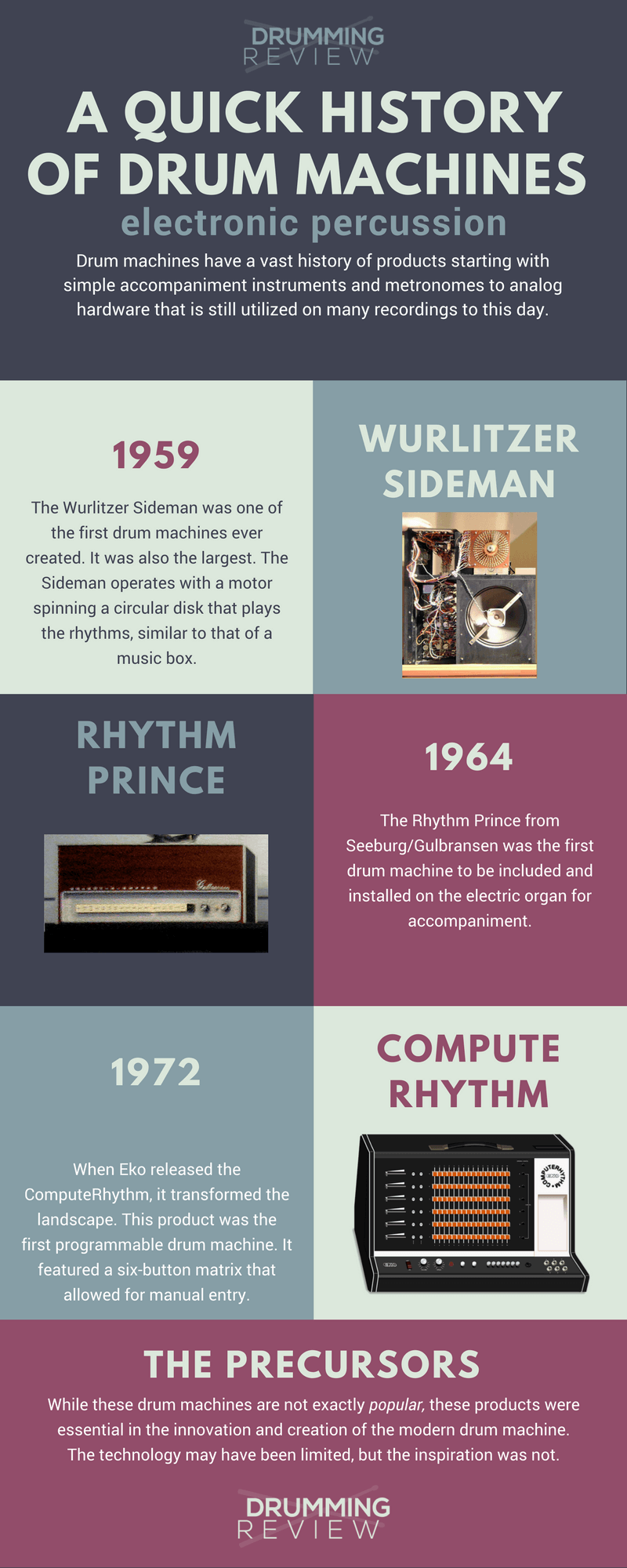
1959 – Wurlitzer Sideman
The very first electronic drum machine was the 1959 Wurlitzer Sideman. It was designed specifically for accompaniment, allowing piano players and organists to play along with a groove.
Unfortunately, we do not have any audio samples of this drum machine.
It operates with a large motor that spins a large circular disc that I believe is playing all the sounds you hear, similar to how a music box works.
Depending on how fast the motor spins determines the tempo of the groove (between 34 and 150 beats per minute).
This thing is large. It’s housed in a wooden frame that looks just like an entertainment center from the 1950s.
There have been some sales of these drum machines on Reverb.com, but for the most part, they’re extremely rare.
The development of this drum machine raised issues with the musicians’ unions, which believed that the invention of the drum machine would replace the work of real musicians.
They ruled that the Sideman could only be used in cocktail lounges if the keyboard player of the evening was paid three times the amount of a normal gig.
Production of the Sideman ran for ten years.
1964 – The Rhythm Prince created by Seeburg/Gulbransen
After the success of the Sideman, two manufacturing companies partnered up to create what is known as the Rhythm Prince.
This drum machine was much smaller than its predecessor, but it still was around the size of a guitar amp head, even somewhat resembling one.
After experimenting with tactics to reduce the size of the instrument, Seeburg was able to develop a compact electronic rhythm pattern generator using what’s known as a diode matrix.
The Select-A-Rhythm was much smaller and was eventually installed on electronic organs for accompaniment and the drum machine finally began to gain popularity.
1972 – The ComputeRhythm from Eko
Finding one of these retro drum machines is going to cost you, big time. In fact, I found a listing on Reverb.com that was priced at $11,269.88 plus shipping.
Now I don’t think the listing sold, but you can see how rare the ComputeRhythm really is.
This drum machine is one of the rarest and most sought-after vintage pieces of gear. Why is this drum machine so valuable?
It doesn’t sound that great. It’s a very basic analog rhythm machine by today’s standards.
While it did have a revolutionary six-row matrix for programming beats, fewer than twenty of these units were actually sold.
You can imagine how rare it is to find one of these.
The ComputeRhythm appeared on records of two iconic electronic musicians: Manual Göttsching and Jean-Michel Jarre.
Wrapping Up
Do you currently use drum machines in your music production? Which one is your favorite? Be sure to let us know down below in the comments.
I appreciate you taking the time to read through and support our website.
Images throughout courtesy of NativeInstruments.com, Akai.com, Alesis.com, and featured image Copyright: brizmaker / 123RF Stock Photo
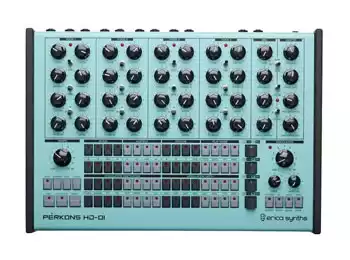
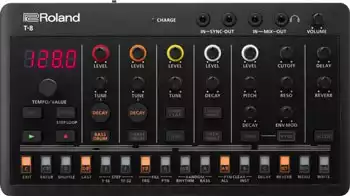
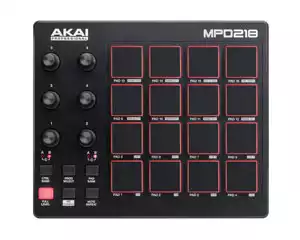
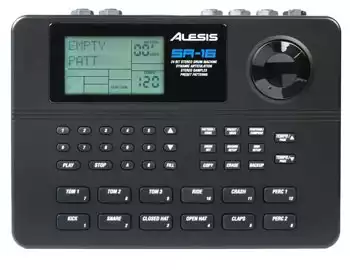

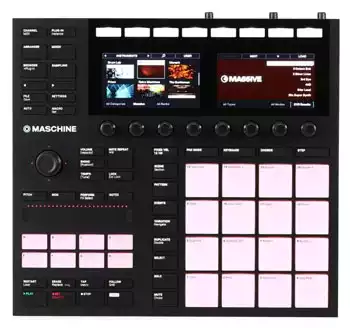

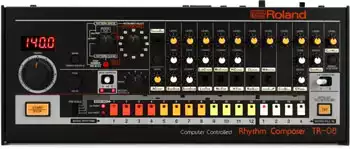
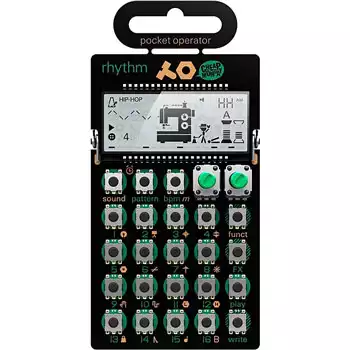
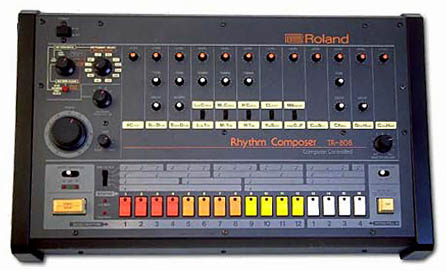
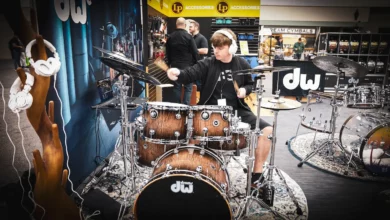

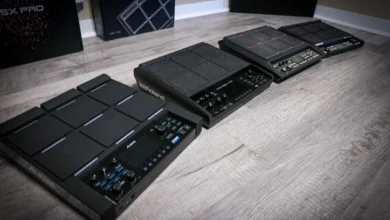
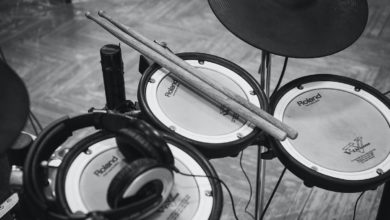
Actually I’d say go with the beat buddy pedal size drum machine. As a solo artist I can tell you it’s unreal and sounds so realistic not to mention easy to use. Why it’s not listed blows my mind??? Ignore all these and buy the beat buddy as it’s by far a better drum machine & you can figure it out quickly. Lastly, it has a downloadable library of Soo many real songs you can add as it’s a pedal that can be upgraded for free. So if you want the best live application it’s the best buddy !! Not any of this stuff( DON’T WASTE YOUR $)
0
The picture with the difference between analogue and digital is simply wrong.
0
I am a one-man show, wishing to add a simple-to-use drum machine to my instrument’s performance. I want to keep it simple. I do mostly ‘oldies’, ‘country classics’, and some ‘gospel’. I don’t need a large number of different beats. A plus would be if another instrument (2nd one) could plug in and, if a microphone could also be plugged in. Is there such a thing as a permanent rechargeable battery machine? That would be useful. What machine would you recommend that would have most/all of these features, and that would be economical, say around $150.00 (Canadian)?
0
How do you give advice to people if you do not even have an understanding of the most basic concepts of music production? Digital signals DO NOT have jagged edges. Perfectly smooth sine waves can be recreated by just defining two points of a half cycle of a wave. Look up the Nyquist-Shannon sampling theorem.
0
ALL OF THESE UNITS ARE PRE 2023! Why not the Korg Drumlogue? I just got it and it’s amazing. It’s my remix in a box
0